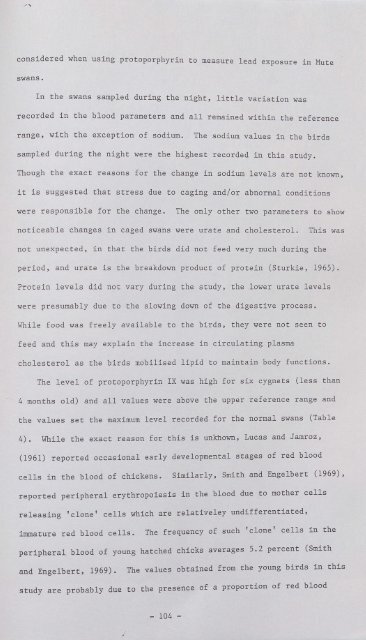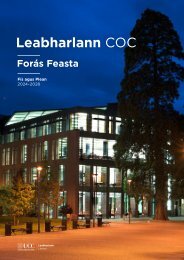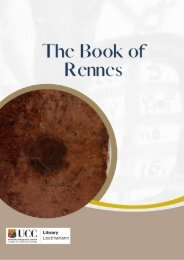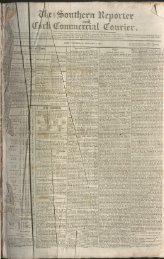Lead Toxicity in Mute Swans
LEAD TOXICITY IN MUTE SWANS Cygnus olor (Gmelin). By JOHN O'HALLORAN A thesis submitted to the National University of Ireland in candidature for the degree of Doctor of Philosophy September 1987
LEAD TOXICITY IN MUTE SWANS
Cygnus olor (Gmelin).
By
JOHN O'HALLORAN
A thesis submitted to the National University of Ireland
in candidature for the degree of Doctor of Philosophy
September 1987
You also want an ePaper? Increase the reach of your titles
YUMPU automatically turns print PDFs into web optimized ePapers that Google loves.
considered when us<strong>in</strong>g protoporphyr<strong>in</strong> to measure lead exposure <strong>in</strong> <strong>Mute</strong><br />
swans.<br />
In the swans sampled dur<strong>in</strong>g the night, little variation was<br />
recorded <strong>in</strong> the blood parameters and all rema<strong>in</strong>ed with<strong>in</strong> the reference<br />
range, with the exception of sodium.<br />
The sodium values <strong>in</strong> the birds<br />
sampled dur<strong>in</strong>g the night were the highest recorded <strong>in</strong> this study.<br />
Though the exact reasons for the change <strong>in</strong> sodium levels are not known,<br />
it is suggested that stress due to cag<strong>in</strong>g and/or abnormal conditions<br />
were responsible for the change.<br />
The only other two parameters to show<br />
noticeable changes <strong>in</strong> caged swans were urate and cholesterol.<br />
This was<br />
not unexpected, <strong>in</strong> that the birds did not feed very much dur<strong>in</strong>g the<br />
period, and urate is the breakdown product of prote<strong>in</strong> (Sturkie, 1965).<br />
Prote<strong>in</strong> levels did not vary dur<strong>in</strong>g the study, the lower urate levels<br />
were presumably due to the slow<strong>in</strong>g down of the digestive process.<br />
While food was freely available to the birds, they were not seen to<br />
feed and this may expla<strong>in</strong> the <strong>in</strong>crease <strong>in</strong> circulat<strong>in</strong>g plasma<br />
cholesterol as the birds mobilised lipid to ma<strong>in</strong>ta<strong>in</strong> body functions.<br />
The level of protoporphyr<strong>in</strong> IX was high for six cygnets (less than<br />
4 months old) and all values were above the upper reference range and<br />
the values set the maximum level recorded for the normal swans (Table<br />
4). While the exact reason for this is unknown, Lucas and Jamroz,<br />
(1961) reported occasional early developmental stages of red blood<br />
cells <strong>in</strong> the blood of chickens. Similarly, Smith and Engelbert (1969),<br />
reported peripheral erythropoiesis <strong>in</strong> the blood due to mother cells<br />
releas<strong>in</strong>g 'clone' cells which are relativeley undifferentiated,<br />
immature red blood cells. The frequency of such 'clone' cells <strong>in</strong> the<br />
peripheral blood of young hatched chicks averages 5.2 percent (Smith<br />
and Engelbert, 1969).<br />
The values obta<strong>in</strong>ed from the young birds <strong>in</strong> this<br />
study are probably due to the presence of a proportion of red blood<br />
- 104 -<br />
I<br />
r
















